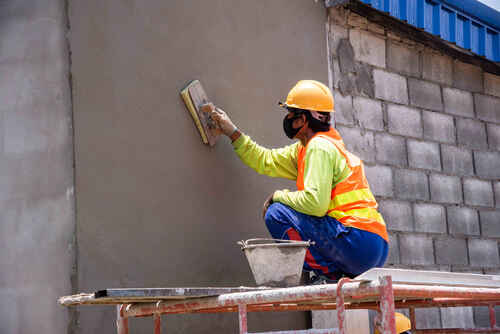Plastering Service Providers: Specialist Surfaces for Your Office Or Home
Plastering Service Providers: Specialist Surfaces for Your Office Or Home
Blog Article
Key Tips and Devices for Effective Smudging in Your Home Improvement Ventures
Attaining a remarkable plaster coating in your home renovation projects calls for a blend of the right devices and tested strategies. Understanding the nuances of blending plaster and applying it in thin layers can significantly affect the final outcome.
Necessary Smudging Tools
The important tools encompass a variety of implements created to promote the smudging procedure successfully and effectively. Key components consist of a hawk, which is a level, square tool made use of to hold the plaster while applying it to surfaces.

Furthermore, a blending bucket is essential for preparing plaster, making certain the best uniformity prior to application. A gluing brush or sponge works for finishing touches and smoothing out structures. Finally, safety and security tools such as gloves and masks must be included to protect the customer from dirt and chemicals. With each other, these important plastering tools make it possible for both experts and do it yourself enthusiasts to accomplish high-quality outcomes in their smudging projects.
Surface Preparation Techniques
Appropriately preparing the surface area before plastering is critical for making sure adhesion and attaining a flawless finish. The very first step includes cleansing the surface area to get rid of any kind of dirt, oil, or old paint that might hinder the plaster's capability to bond effectively. A thorough laundry with an appropriate cleansing remedy is recommended, complied with by rinsing and enabling the surface to dry completely.
Next, evaluate the surface area for any kind of splits or flaws. These need to be full of a suitable filler substance and allowed to heal according to the manufacturer's instructions. For permeable surface areas, applying a primer is necessary to enhance and develop a consistent structure adhesion.
In addition, it is crucial to ensure that the surface area is secure and structurally noise. Any loosened products, such as flaking paint or damaged drywall, should be repaired or gotten rid of. Think about utilizing a scrape coat to boost hold. if working with stonework surface areas.
Mixing Plaster Like a Pro

Making use of a clean mixing container, pour the water first, then slowly include the plaster powder while mixing constantly - Plastering. This approach helps to prevent clumping and makes sure an also distribution of materials. A mechanical mixer can be useful, supplying constant outcomes and conserving time. Go for a velvety, lump-free consistency that enables for easy spreading however is thick sufficient to hold its shape without running.
As soon as mixed, allow the plaster to rest for a couple of mins to make it possible for the gypsum crystals to moisten fully. This pause boosts workability and minimizes the risk of fracturing during application. By complying with these actions, you can mix plaster like a pro, setting the structure for a successful gluing job in your house enhancement ventures.
Application Approaches for Smooth Finishes
With the plaster mixture prepared to the excellent consistency, the following step involves selecting ideal application approaches to attain a smooth coating. This device enables for a fine, also circulation of plaster throughout the surface area while reducing trowel marks.
Begin by using a generous quantity of plaster to the surface area using the trowel, guaranteeing it sticks well. Utilize a methodical strategy, working from the bottom higher. Once the first layer is used, make use of a sweeping motion to smooth the surface area, using even stress. In locations that call for even more precise focus, consider utilizing a float, which can assist remove any flaws and develop a consistent appearance.
For the last touches, a damp sponge can be used to refine the surface area further. Gently mist the plaster with water and delicately massage the surface area to attain a polished effect. Constantly remember to operate in little sections to preserve control over the application process, ensuring a smooth, expert coating throughout your plastering project.
Usual Errors to Prevent
When starting a plastering job, preventing usual mistakes is important for accomplishing a perfect finish. Among the most common mistakes is ignoring surface preparation. Falling short to clean and fix the substrate can lead to bad attachment and unequal surface areas. Make sure that all dust, oil, and loose materials are eliminated before applying plaster.
One more common mistake is applying plaster too thickly. Thick layers can fracture as they dry, compromising the integrity of the finish. Rather, choose several slim layers, enabling each coat to completely dry entirely prior to applying the next.
Additionally, bad mixing strategies can lead to irregular texture discover this info here and workability. Always comply with the producer's instructions for blending ratios and completely blend the plaster to attain an uniform uniformity.

Timing also plays a critical duty; plaster needs to be applied while the substrate this is moist to boost adhesion. Top notch trowels and drifts can make a significant distinction in attaining a smooth finish.
Final Thought
Reliable plastering needs an extensive understanding of essential tools and strategies. Proficiency of these components not just adds to the visual appeal of an area yet likewise guarantees longevity and long life in plastering projects, making them important to effective home improvement endeavors.
A float is another crucial tool, which assists in leveling the plaster and achieving a consistent surface.

By complying with these steps, you can blend plaster like a pro, setting the structure for a successful plastering task in your home renovation ventures.
Gently haze the plaster with water and carefully rub the surface area to achieve a sleek impact.
Report this page